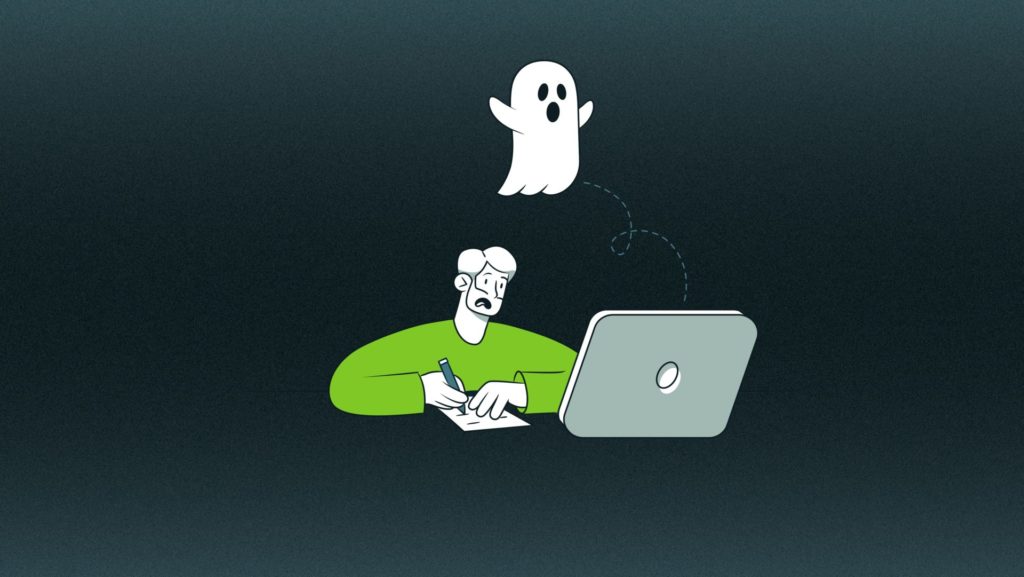It happened once again — a candidate that checked all the boxes you needed and were looking forward to offering a position to no calls, no shows to an interview. Your recruiters are forced to return to square one to search for another qualified candidate. While candidate ghosting might be an easier pill to swallow than a date standing you up, how often this occurs only exacerbates today’s hiring challenges.
Earlier this year we discussed how some of Hireology’s customers are successfully combating ghosting in their hiring processes, but now we have firsthand insight as to why candidates are skipping out on interviews in the first place. The findings we gleaned from over 6,000 respondents to our latest study, The Great Reassessment, can help you overcome this modern hiring challenge and put you back on track to meeting your hiring goals.
We’ve compiled the top three reasons applicants gave as to why they’ve ghosted companies before, along with practical suggestions to avoid this trend from leaving your organization high and dry again.
The hiring process took too long
While it might be years since you personally went through an interview for a position at another company, if you feel like your current hiring process is taking too long — you’re probably right. In fact, 43% of the survey respondents who said they’ve ghosted in the past stated that they did so because the process was taking too long to complete. Simply put, the longer your interview and hiring processes stretch out, the harder it is to keep top talent engaged.
In fact, about a third of recent hires surveyed said they were hired in less than two weeks. So if your company takes more than two weeks from the time a candidate submits their application to the time they’re offered a position, you’re losing out on the best talent on the hiring market. We’re not just saying this as a catch-all solution either — 41% of applicants stated that they ghosted during the interview process because they had already received another offer. The same study revealed that in 2022, you’re competing against approximately 16 other companies for the same candidates!
One of the easiest ways to keep great talent from moving onto other opportunities is to speed up your hiring process, whether that’s through allowing candidates to arrange interviews with recruiters based on both parties’ availability, prescreening tests to weed out unqualified candidates, or jumpstarting your onboarding process by collecting vital documents before their first day on the job.
They lost interest in the role once more details were given
There’s nothing that quite matches the sting of signing up for an experience — or a job — that falls flat of what was portrayed. Unfortunately, that’s what another 41% of applicants who have ghosted said caused them to abandon opportunities they were previously interested in.
Writing job descriptions that depict the role while also following SEO guidelines is both a science and an art that takes some practice to craft correctly. Many companies incorrectly assume that if they cram the title into the description as many times as possible that they’ll receive an influx of applicants, but that’s not the case.
Instead, focus on writing job descriptions for and to the people you want to hire. You want to include the benefits you’re offering (e.g., flexibility, career growth opportunities), the duties the role will be responsible for in the typical day-to-day operations, and a sneak peek at what your company’s culture looks like. At Hireology we typically encourage customers to follow a job description formula when crafting your available roles that includes the following sections:
- A brief job summary that covers the job title and expectations
- Benefits and other employee perks
- Responsibilities in the role
- Requirements and qualifications
- Company blurb
- Equal employment opportunity statement
Your company seemed unorganized and unprepared
Another common reason your candidates are ghosting? Your team appears unorganized and unprepared. In fact 40% of survey respondents who have ghosted cited this as a reason. The way you present yourself to candidates in the process is a reflection of what it will be like working for you. If the candidate feels that you’re unorganized when it comes to hiring and interviewing, they’ll assume the rest of the company is too.
That’s why having a clearly defined, step-by-step hiring process is so important — it ensures that all of your recruiters and hiring managers know exactly what to do at each step of the process as well as how long each step should take. With a process that everyone understands, your recruiting and hiring teams will run like a well-oiled machine — and your candidates will take note. Additionally, it’s important to have protocol in place around interview questions. You should never repeat questions from interview to interview and anyone going into an interview should know how the candidate answered previous questions in earlier interviews.
Modern applicant tracking systems can help here. With the right tool you can set standard steps to follow during the hiring process, keep notes about candidates that everyone involved can access, prepare tailored interview questions for each candidate, communicate with your team in one centralized location, and much more. This way, information isn’t living across disparate systems and your team can remain organized and prepared.
Main takeaway
According to our research, what determines whether a candidate will ghost or not is generally how well they’re treated during the interview process. If your company is taking too long to make a decision, give vague descriptions of what their work lives will look like once they’re employed for you, or seem disorganized or unprepared during the hiring process, you’re losing out on top talent. Getting them on the phone once isn’t a guarantee that they’re so excited for your company that they won’t accept the first offer they’re handed — especially since there are 1.9 vacant positions awaiting every job seeker. With the solutions mentioned above, you’ll be meeting and exceeding your hiring goals in no time.
For more data and insights on today’s applicant expectations, download our 2022 applicant research report The Great Reassessment today.




